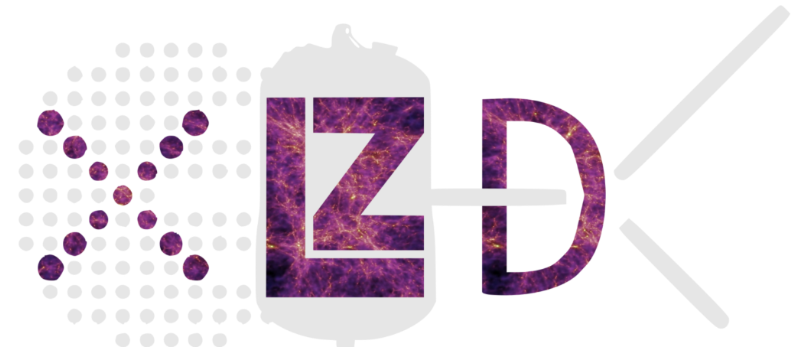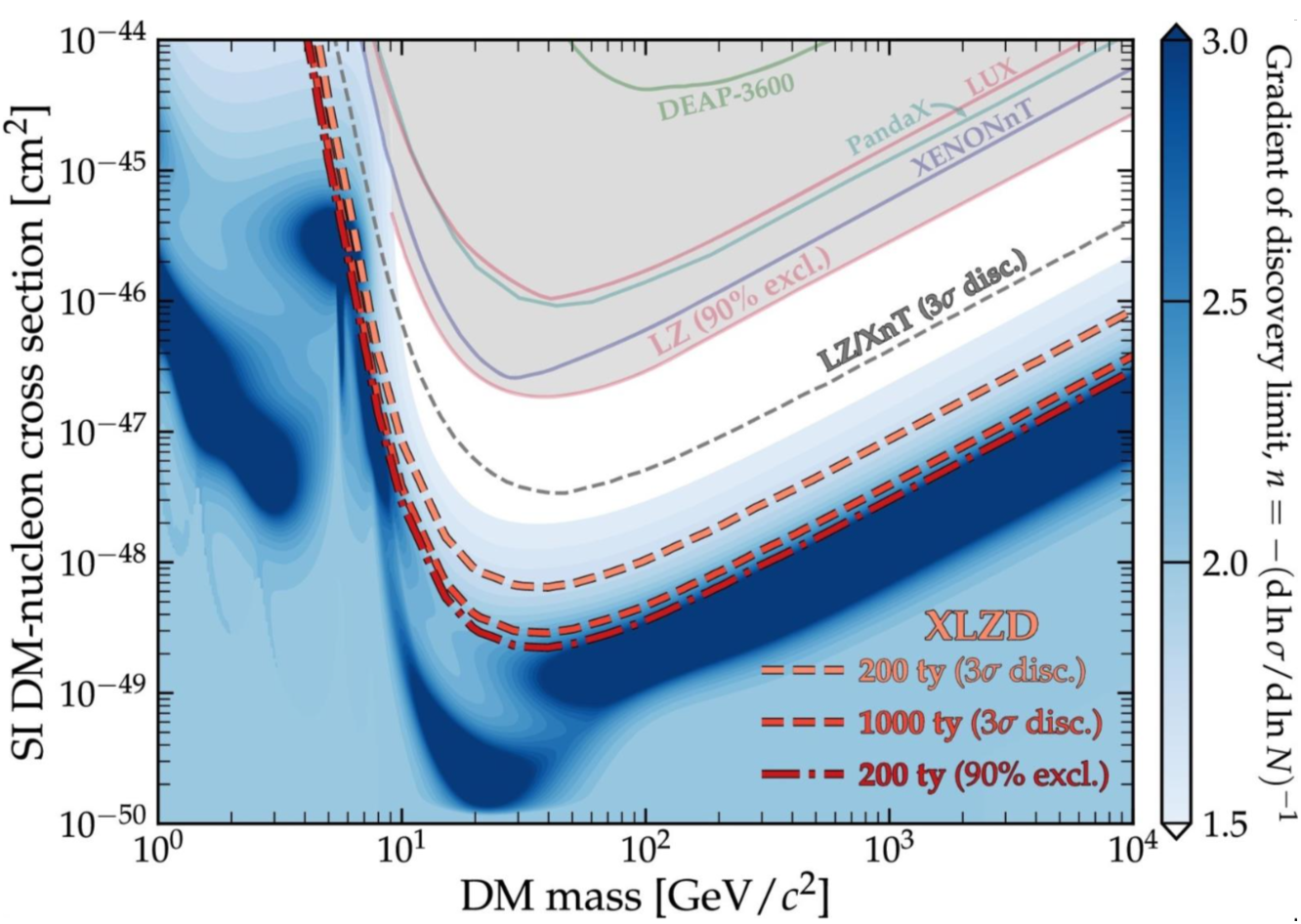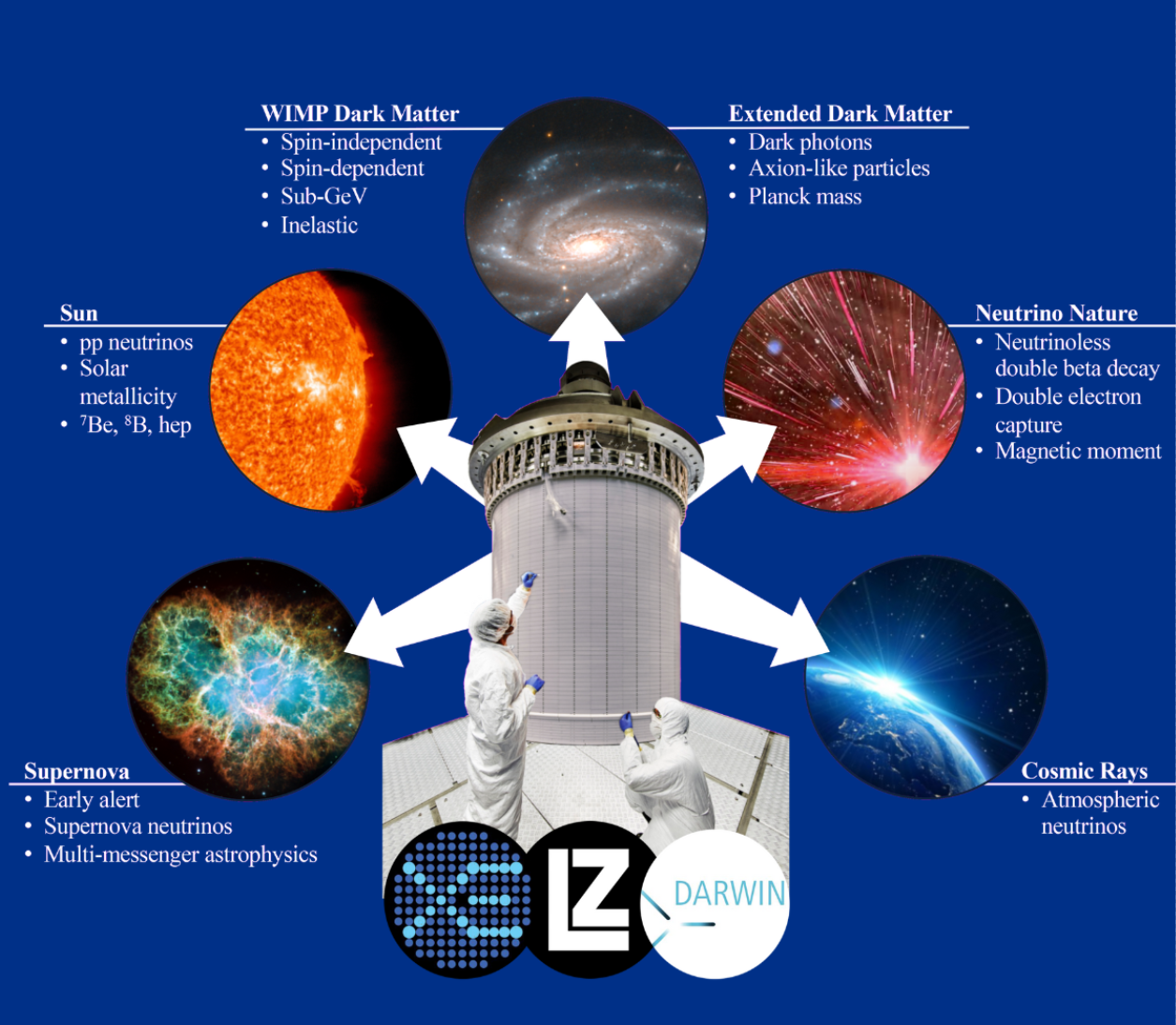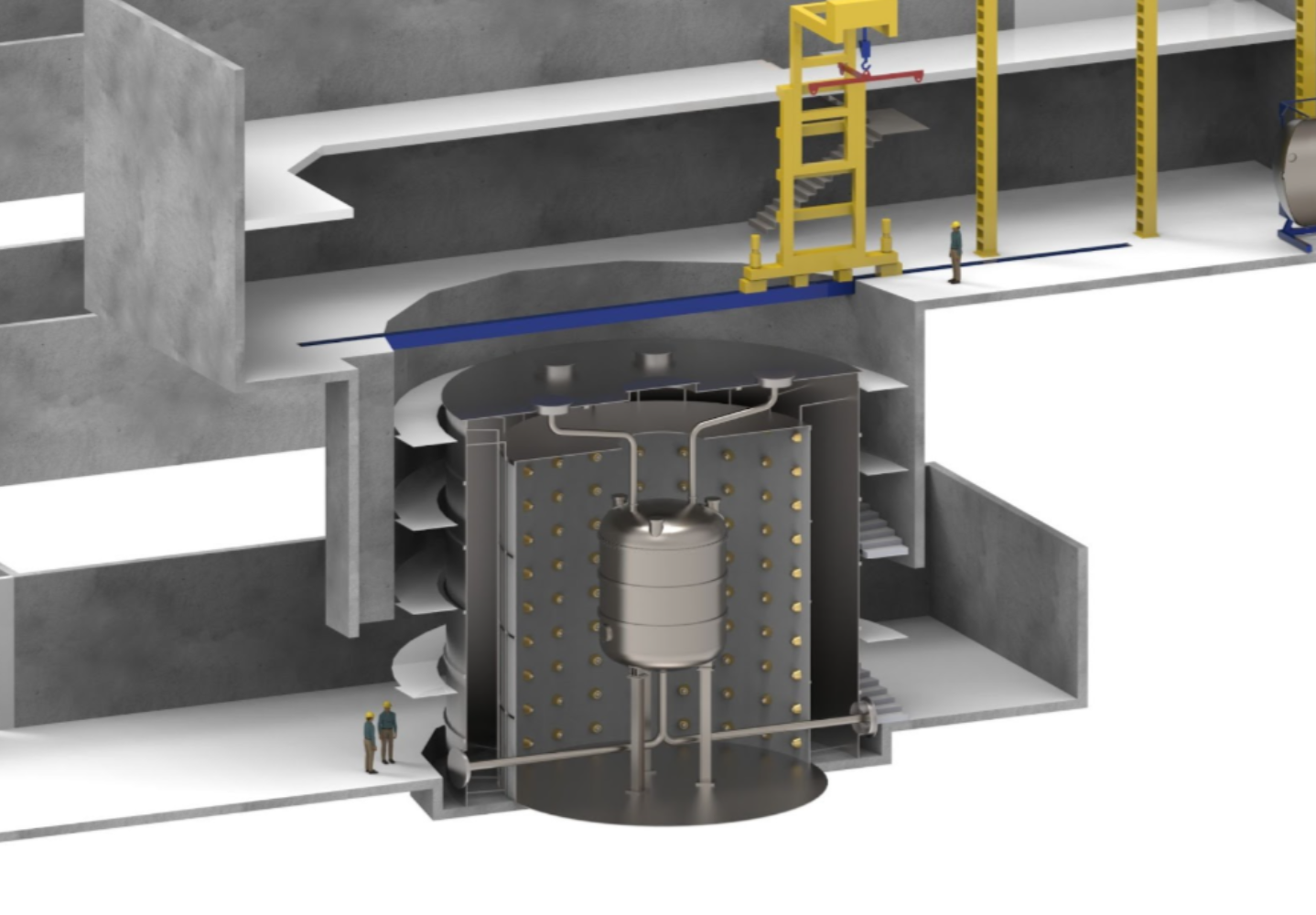The XENON, LUX-ZEPLIN and DARWIN consortium became XLZD in 2024. Over 300 scientists and engineers have gathered to develop a next generation dual phase Time Projection Chamber (TPC) Liquid Xenon observatory. XENON and LUX-ZEPLIN collaborations will combine their years of experience operating multi-Tonne Liquid Xenon detectors with the DARWIN collaboration’s invaluable expertise in design and engineering, to build an impressive and versatile observatory.

The XLZD observatory will probe deep into dark matter parameter space, with world leading sensitivity to dark matter candidates, Weakly Interacting Massive Particles (WIMPs). The collaboration yearns to achieve sensitivity to the experimental limits, the point where the WIMP interaction cross-section approaches or even matches that of neutrino interaction cross section. At this threshold—known as the neutrino floor—further distinction between WIMPs and neutrinos would become very challenging.

Graph displaying XLZD’s sensitivity to Spin Independent WIMP-Nucleon Cross section as a function of Dark matter mass.
Dashed orange and red dotted lines represent XLZD’s projected sensitivity to 200 Tonne years of exposure and 1000 Tonne years respectively. They demonstrate significant improvements over previous experiments, as indicated by the constraints of experiments such as LUX-ZEPLIN, seen within the grey bounds.
The background shading indicates discovery potential, darker areas indicate the ‘neutrino floor’, beyond which distinguishing signals from background becomes increasingly challenging.
Graph by Ciaran O’ Hare. Derived from DOI : https://doi.org/10.1016/j.nuclphysb.2024.116473
The facility would also tackle fundamental questions about the universe, allowing for scientists to observe phenomena that extend beyond our current understanding of particle physics and the Standard Model. For instance, alongside their search for WIMPs, XLZD’s very low background and large volume would allow for exploration into rare phenomena such as neutrino less double beta decay. This event is thought to occur at most, once every 1026 years, with a possibility of occurring from the naturally abundant 136 Xe isotope. XLZD aims to investigate whether this effect occurs within its detector. Its observation would suggest the neutrino acts as its own antiparticle - called a Majorana particle – which could help explain the matter – antimatter imbalance and fundamentally reshape our understanding of particle physics.
XLZD is a versatile tool for advancing particle physics, the observatory could be able to lead searches for rare nuclear decays, astrophysical neutrinos and exotic dark matter models.

Summary of XLZD’s projected science programme – Bottom 3 circles shows the logos of the 3 collaborations that make up XLZD, XENON, LUX-ZEPLIN, DARWIN.
Diagram from XLZD collaboration website
XLZD experimental mechanism
Dual phase Time Projection Chambers (TPCs) have been used to search for dark matter candidates since the deployment of the ZEPLIN-II experiment 19 years ago. The dark matter community believes WIMPs are consistently travelling through vast amounts of matter. Dark matter detectors are designed to detect signals from the rare instances weak interactions with matter occur.
A theoretical dark matter particle collides with Xenon nuclei contained within the detector, transferring energy to the nucleus causing it to recoil. This energy contributes to two detectable processes, ionisation and excitation of the surrounding Xe atoms. The latter produces prompt scintillation photons in the vacuum ultraviolet range (175nm). This prompt ‘burst of light’ is immediately detected via photon sensors sensitive to this spectrum - at the bottom of the TPC. Ionisation produces free charges, which under the influence of a constant electric field, travel upwards towards a layer of Xenon vapour. After extraction into the xenon vapour by a stronger electric field and acceleration within this field, the electrons emit electroluminescence, generating a delayed signal known as S2, the resulting VUV photons are then detected by an array of photon sensors.
Analysis of S1 and S2 signals allows for an accurate reconstruction of particle mass and help determine where this collision took place within the detector.
WIMP searches: Context and requirements
Successful searches for WIMPs have been conducted using dual phase TPCs by both the XENON and LUX ZEPLIN collaborations. These collaborations conducted complementary direct dark matter searches; with LUX-ZEPLIN setting world leading constraints for the dark matter candidates in 2022 and again in 2024. The desired WIMP - nuclei interactions have proven to be extremely rare. For instance, throughout its first 2 science runs the LUX-ZEPLIN experiment did not observe any dark matter candidate event with 4.2 Tonne - Years of exposure. To maximise the likelihood of WIMP interactions, XLZD will manufacture a cryostat with a volume an order of magnitude over the LUX-ZEPLIN/ XENONnT experiments. The cryostat will initially contain 60 tons of liquid xenon, with the potential to expand to 80 tons after several years of operation. The former is projected to generate an impressive 200 Tonne-Years of exposure throughout its planned runs.
Suppression of background is essential to achieving this sensitivity. All detector components naturally contain trace amounts of radioactive isotopes, their decay can produce interfering signals. XLZD construct its components out of radiologically pure materials, conducting a series of assays to ensure this intrinsic radiation is neglible.
Additionally, all detector components will undergo construction within cleanrooms to minimise dust / airborne particulates that may interfere with signal detection. The detector will also be housed deep underground, at a site yet to be determined, where 1000s of metres of earth will provide natural shielding and significantly reduce interference from cosmic ray muons. Multiple detectors will be employed to identify and reject these interfering events. These ‘Veto’ systems will surround the 60T active LXe chamber and can rule out dark matter interactions by detecting background signals.
XLZD apparatus
At the centre of the experiment is the TPC, a cylindrical chamber containing 60 Tonnes of LXe. Scintillation photons produced will be directed towards photo sensor arrays by a cage of highly reflective polytetrafluoroethylene (PTFE), lining the sides of the TPC. The initial S1 signal is detected by a photon sensor array at the TPC’s base, whilst the S2 signal is detected by a photon sensor array at the top of the chamber. Wire meshes across the chamber induce strong electric fields that induce drift and then extraction to the gaseous phase, that generate this signal.
 XLZD 3D rendering of XLZD cryostat. Image obtained from https://doi.org/10.1016/j.nuclphysb.2024.116473.
XLZD 3D rendering of XLZD cryostat. Image obtained from https://doi.org/10.1016/j.nuclphysb.2024.116473.
The TPC is considered the inner layer of the cryostat. The cryostat’s outer layer is a LXe ‘skin’, a thin 7cm layer around most of the chamber. The 7 Tonnes of liquid xenon contained within this outer layer mitigates any background produced by gamma ray photons.
The vacuum sealed; double walled cryostat is encompassed by a neutron veto detector. This neutron veto detector will enhance background rejection using a novel detection media, mixing water with liquid scintillator and doping this with Gadolinium. Gadolinium has a high neutron cross section; promoting neutron capture. Neutron capture results in the emission of Gamma rays. These gamma rays induce both: scintillation light from liquid scintillator and Cerenkov radiation from the water. This dual signal is detected by PMTs lining the walls of the detector. Production of two distinct signatures mitigates neutron background and improves event identification. Surrounding the neutron veto detector is the outermost layer, a water shield acting as a muon veto and for external sources of background like gamma photons / neutrons. This colossal cylinder will be outfitted with photomultipliers to detect Cerenkov radiation produced from cosmic ray muons.

A preliminary CAD model of the 6.4 m tall and 3.9 m diameter XLZD cryostat - Located in the proposed Boulby Underground Laboratory and immersed in a water tank for additional shielding against radiation from the laboratory rock—image courtesy of Harry Byrne.
Boulby Underground Laboratory: A strong contender for XLZD
XLZD is within its initial planning phase, with preliminary planning and design work already underway. The site for this experiment is yet to have been selected though Boulby Underground Laboratory (BUL) has submitted a proposal and are shortlisted as one of the 4 final candidates. The ICL-Boulby mine is well suited for the experiment, thanks to its deep underground location, existing infrastructure capable of supporting the experiment and commitment to hosting the project.
BUL have embarked on a concerted effort to promote their selection as XLZD host. Currently an underground excavation is in progress at Boulby, in partnership with ICL to establish a state-of-the-art laboratory site 1100m underground. This facility will include advanced manufacturing capability for the construction of XLZD components and infrastructure. By 2030+, Boulby will have fully outfitted this cavern and will have begun the second stage of the excavation. In this next phase, they plan on venturing deeper into the earth, creating a vast open space 1300m underground to house the XLZD observatory.
UKRI has provided £8 million in preliminary funding to STFC and a consortium of UK universities, led by Imperial College London, to work with BUL across the next 3.5 years.
For more context on the UKRI fund please consult STFC’s press release - Link
The Technology Department will fulfil an important role within this preliminary design phase. The Technology Department will have to overcome many engineering and practical challenges associated with constructing the experiment and its infrastructure deep underground at Boulby, it is their responsibility to understand and help prepare for these challenges.
Technology Department will correspond with engineering teams from across the international XLZD consortium, to coordinate the delivery of various subsystems. Having sourced these subsystems, they will ensure their safe and efficient integration and installation. The Technology Department have also been tasked with the preparation of designing project specific infrastructure for XLZD, developing facility components that will support the experiment.
More detail on the project can be found here
Particle Physics Department at RAL contributions
Material search and cryostat design
PPD’s will closely collaborate with Technology Department, to design the Cryostat and identify material that satisfy the stringent cleanliness requirements. Drawing from their experience in the LUX-ZEPLIN experiment, Technology Department will help PPD to design and assist with the manufacture of the XLZD cryostat. Using the recently commissioned Cold Radon Emanation Facility (CREF) at RAL and a newly established electroforming / electroplating facility at Boulby, PPD will conduct a thorough material search campaign for XLZD’s cryostat and components. CREF will conduct detailed radio assays on material candidates while the electroforming facility will focus on identifying methods that further minimise background interference.
PPD’s press release detailing our contributions can be found here
Contact - jens.dopke@stfc.ac.uk
PPD will help source unpurified Xenon for the detector, delivering it to international collaborators for purification of Krypton and Radon contaminants. Besides Xenon procurement, PPD will develop systems for Xenon storage, feed and recovery.
The relative scarcity along with the extensive purification process of Xenon demands the utmost caution during storage. PPD will maintain a Xenon’s high purity by carefully monitoring its volume when contained in cylinder packs, ensuring a purity at the part per trillion degree.
To provide the detector with Xenon gas and recirculate it within the detector, PPD will design a primary gas handling system. Our design, produced in conjunction with industrial partners, will ensure contaminants are not introduced to the detector.
Recovering gaseous xenon during routine maintenance cycles or emergencies, such as cooling system failures, is essential. Since the cryostat is not a high-pressure vessel, PPD must develop extraction mechanisms to prevent overpressure. To address this, PPD are designing a control system to set extraction conditions, along with compressors capable of efficiently extracting and recompressing the xenon for secure storage.
Contact - christopher.townsley@stfc.ac.uk
PPD project management office will oversee communication and strategic planning among both national and international collaborators. To ensure seamless coordination among collaboration members, project management will help with scheduling, management data analytics, risk management and overall project control. Plans to develop the budget for the construction phase are already underway, these plans will ensure the collaboration remains within a well-defined budget with realistic cost expectations.
